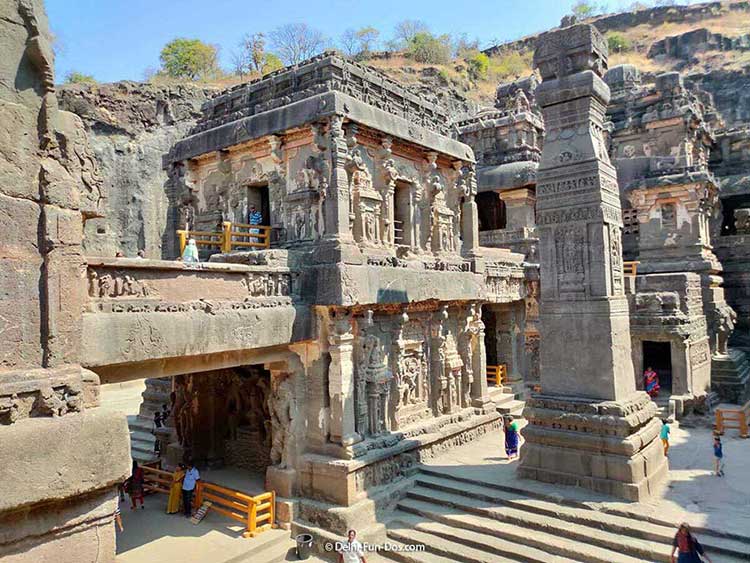ॐ श्री गुरुभ्यो नमः ॐ श्री शिवानन्दाय नमः ॐ श्री चिदानन्दाय नमःॐ श्री दुर्गायै नमः
Source of all Images in this Blog-post : Google Images : ‘Google Image Search’ will reveal the multiple sources of every single image shared here. For more details, kindly see ‘Disclaimer‘
The Kailasha or Kailashanatha temple is the largest of the rock-cut Hindu temples at the Ellora Caves, Maharashtra, India.

A megalith carved from a rock cliff face, it is considered one of the most remarkable cave temples in the world because of its size, architecture and sculptural treatment, and the climax of the rock-cut phase of Indian architecture.
The top of the superstructure over the sanctuary is 107 feet above the level of the court below, although the rock face slopes downwards from the rear of the temple to the front. Archaelogists believe it is made from a single rock.

The Kailasa temple (Cave 16) is the largest of the 34 Buddhist, Jain and Hindu cave temples and monasteries known collectively as the Ellora Caves, ranging for over 2 kilometres along the sloping basalt cliff at the site.

Most of the excavation of the temple is generally attributed to the eighth century Rashtrakuta King Krishna I (r. c. 756 – 773), with some elements completed later.
The temple architecture shows traces of Pallava and Chalukya styles. The temple contains a number of relief and free-standing sculptures on a grand scale equal to the architecture, though only traces remain of the paintings which originally decorated the temple.

Kailasa temple was commissioned by a Rashtrakuta ruler. Its construction is generally attributed to the Rashtrakuta King Krishna I (r. 756-773 CE)

The temple features the use of multiple distinct architectural and sculptural styles. This, combined with its relatively large size, has led some historians to believe that its construction spanned the reigns of multiple kings.

The Kailasa Temple is notable for its vertical excavation – carvers started at the top of the original rock and excavated downward. The traditional methods were rigidly followed by the master architect which could not have been achieved by excavating from the front.
Architecture :
The Kailasa temple architecture is different from the earlier style prevalent in the Deccan region of south India. As stated above, it appears to be based on the Virupaksha Temple at Pattadakal and the Kailasa temple at Kanchi, but it is not an exact imitation of these two temples.
The southern influence on the temple architecture can be attributed to the involvement of Chalukya and Pallava artisans in its construction. The indigenous Deccan artisans appear to have played a subordinate role in the temple’s construction.

The entrance to the temple courtyard features a low Gopuram. Most of the deities at the left of the entrance are Shaivaite (affiliated with Shiva) while on the right hand side the deities are Vaishnavaites (affiliated with Vishnu).

A two-storeyed gateway opens to reveal a U-shaped courtyard. The dimensions of the courtyard are 82 m x 46 m at the base. The courtyard is edged by an arcade three stories high. The arcades are punctuated by huge sculpted panels, and alcoves containing enormous sculptures of a variety of deities.
Originally flying bridges of stone connected these galleries to central temple structures, but these bridges have fallen. Some of the most famous sculptures are Shiva the ascetic, Shiva the dancer, Shiva being warned by Parvati about the demon Ravana, and river goddess.
Within the courtyard, there is a central shrine dedicated to Shiva, and an image of his Vahana (mount) Nandi (the Sacred Bull).
The central shrine housing the Lingam features a flat-roofed Mandapa supported by 16 pillars, and a Dravidian Shikhara.
The shrine complete with pillars, windows, inner and outer rooms, gathering halls, and an enormous stone lingam at its heart is carved with niches, plasters, windows as well as images of deities, Mithunas (erotic male and female figures) and other figures.
As is traditional in Shiva temples, Nandi sits on a porch in front of the central temple. The Nandi Mandapa and main Shiva temple are each about 7 metres high, and built on two storeys. The lower stories of the Nandi Mandapa are both solid structures, decorated with elaborate illustrative carvings.
The base of the temple has been carved to suggest that elephants are holding the structure aloft. A rock bridge connects the Nandi Mandapa to the porch of the temple. The base of the temple hall features scenes from the Hindu epics Mahabharata and Ramayana.
